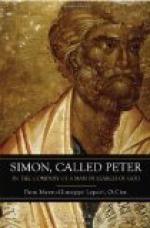He shrugged his shoulders. “Come on,” he said; “your notions are all topsy-turvy, Julie. Come and look at the monuments.”
They wandered down the transept, and observed the majesty of England in stone, robed in togas, declaiming to the Almighty, and obviously convinced that He would be intensely interested; or perhaps dying in the arms of a semi-dressed female, with funeral urns or ships or cannon In the background; or, at least in one case, crouching hopelessly, before the dart of a triumphant death. Julie was certainly impressed, “They are all like ancient Romans, Peter,” she said, “and much more striking than those Cardinals and Bishops and Kings, kneeling at prayer, in Rouen Cathedral. But, still, they were not ancient Romans, were they? They were all Christains, I suppose. Is there a Christian monument anywhere about?”
“I don’t know,” said Peter, “but we’ll walk round and see.”
They made a lengthy pilgrimage, and finally Peter arrested her. “Here’s one,” he said.
A Georgian Bishop in bas-relief looked down on them, fat and comfortable. In front of him was a monstrous cup, and a plate piled with biggish squares of stone. Julie did not realise what it was. “What’s he doing with all that lump-sugar?” she demanded.
Peter was really a bit horrified. “You’re an appalling pagan,” he said. “Come away!” And they came.
They roamed along the Embankment. Julie was as curious as a child, and wanted to know all about everything, from Boadicea, Cleopatra’s Needle, and the Temple Church, to Dewar’s Whisky Works and the Hotel Cecil. Thereabouts, Julie asked the name of the squat tower and old red-brick buildings opposite, and when she heard it was Lambeth Palace instantly demanded to visit it. Peter was doubtful if they could, but they crossed to see, and they were shown a good deal by the courtesy of the authorities. The Archbishop was away, to Peter’s great relief, for as likely as not Julie would have insisted on an introduction, but they saw the chapel and the dining-hall amongst other things. The long line of portraits fascinated her, but not as it fascinated Peter. The significance of the change in the costumes of the portraits struck him for the first time—first the cope and mitre and cross, then the skull-cap and the tippet, then the balloon-sleeves and the wig, then the coat and breeches and white cravat, then the academic robes, and then a purple cassock. Its interest to Julie was other, however. “Peter,” she whispered, “perhaps you’ll be there one day.”
He looked at her sharply, but she was not mocking him, and, marvelling at her simplicity and honest innocence, he relaxed into a smile. “Not very likely, my dear,” he said. “In other days a pleasant underground cell in the Lollards’ Tower would have been more likely.”
Then, of course, Julie must see the famous tower, and see a little of it they did. She wanted to know what Lollardy was; their guide attempted an explanation. Julie was soon bored. “I can’t see why people make such a bother about such things,” she said. “A man’s religion is his own business, surely, and he must settle it for himself. Don’t you think so, Peter?”




